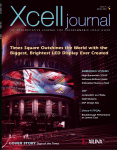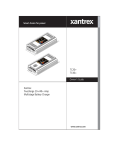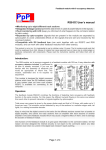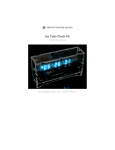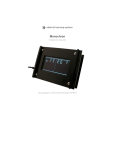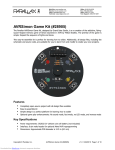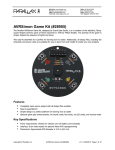Download User`s Manual - Iowa Scaled Engineering, LLC
Transcript
Interlocking-In-A-Box Features • • • • • • • • Fully automatic interlocking with built-in signal logic Ability to simulate trains on any track based on fast time Configurable time lock and timeout delays to suit any application Supports up to one siding on each of the main lines with corresponding signal indications Interfaces with current-based or infrared block detectors (sold separately) Simulated trains can trigger third-party sound modules for enhanced realism Optional automatic interchange can be triggered by simulated trains Simple configuration with the MRGui application Description The Iowa Scaled Engineering Interlocking-In-A-Box (MRB-IIAB) provides the signal logic to control a fully automatic interlocking on a model railroad. It can be used to manage a crossing of two active main lines with signals on both, or more typically, it can be used to manage the crossing of an active (modeled) main line and an inactive (dummy) main line. Each main line can have one siding, on either side of the diamond, and the signals respond prototypically based on the position of the switch points. Figure 1: Complete Track Schematic *Note: Most eastern roads denote an absolute signal with a lower red marker light. Western railroads, however, typically indicate an absolute signal with an "A" or "P" marker plate. In either case, the MRB-IIAB does not control the eastbound or southbound lower signal. As shown in Figure 1, the “west” and “north” tracks have one active signal head per track. On the “east” and “south” tracks, two signal heads can be driven to control access into the siding on the opposite side. Although defined as shown above, the MRB-IIAB is flexible enough to handle other configurations such as no sidings or having sidings on the other sides (e.g. “east” and/or “south”) of the diamond. 1 of 36 $Revision: 1228 $ The MRB-IIAB can also enhance the realism of a dummy main line by simulating trains – and optionally triggering a sound module – preventing movement through the diamond on the active main line while the simulated train is present. Schedules for simulated trains are loaded into the module and then triggered based on fast time from a MRB-FCM fast clock module (sold separately). Up to 32 scheduled trains can be programmed into each MRB-IIAB module. Additionally, each simulated train can also trigger an automatic interchange, delivering cars to be picked up by the next main line train. Track occupancy inputs accept logic-level signals from a variety of occupancy detectors. Both currentbased (DCC) detectors such as the MRB-BD4X and optical/IR detectors such as the CKT-IRSENSE can be used. Other third-party detectors can also be used as long as they provide a logic-level (or opendrain) output. Signals are driven with 5V outputs capable of sourcing 10mA or sinking 20mA each. Configuration options allow the MRB-IIAB to control any combination of common-anode (+) and common-cathode (-) LED signals. Additional circuitry may be needed to drive incandescent type signals – contact us for details. Operation Although highly configurable, the basic operation of the MRB-IIAB is quite simple. It is designed to mimic the operation of a fully automatic interlocking. The first train to arrive at the diamond gets permission to proceed, thus holding off any other trains that may arrive until the diamond has cleared and adequate time has run out on the time lock timer. Several basic cases are presented on the following pages. More complex situations can also be handled, but fundamentally the same logic applies. In addition, any simulated trains are also run according to the same rules, meaning that a real train can delay a simulated one and vice versa. Examples The examples presented below represent some of the most common situations encountered at the interlocking. Yellow distant signals are shown to indicate the start of each approach block. However, the MRB-IIAB does not control these signals – if present, they are assumed to be fixed indications. 2 of 36 $Revision: 1228 $ Eastbound Eastbound train arrives and gets proceed indication: After crossing into the interlocking block, the signal drops to red: The train continues, and the lockout timer on the east approach starts running: The interlocking behaves similarly for a train arriving on the siding. However, the proceed indication will only appear once the switch is thrown for the siding: Westbound Westbound train arrives and gets proceed indication: 3 of 36 $Revision: 1228 $ After crossing into the interlocking block, the signal drops to red: A westbound that intends to take the siding receives a different proceed indication: Eastbound Meets Westbound Eastbound train arrives and gets proceed indication: Westbound train arrives and gets stop indication. Note, this scenario is not unsafe since the signals at the automatic interlocking do not convey authority, just restriction. Train movement in this case would still be governed by time table, train order, track warrant, or other authority: Switch is thrown to the siding. Proceed indication is dropped and time lock timer starts: 4 of 36 $Revision: 1228 $ Westbound gets proceed indication once time lock timer expires: Westbound continues into the siding and the time lock timer starts again: The eastbound get a proceed indication after the switch is thrown and the time lock timer expires: Eastbound Meets Southbound Southbound train arrives and gets proceed indication: Eastbound train arrives and gets stop indication: 5 of 36 $Revision: 1228 $ Southbound continues: Eastbound gets proceed indication once time lock timer expires: Configuration Options In addition to simulating the signal logic, The MRB-IIAB contains several timing parameters used to enhance the operational realism. Each of the four approach blocks and the interlocking block have a timeout value. If a train triggers a detector but then subsequently moves off that detector or out of the block, the MRB-IIAB will assume the train is still present for the amount of time programmed for the timeout. This is useful when using point-type detectors such as Infrared (IR) detectors since short trains may not always completely cover all the detectors in a block. This allows a train to “coast” between detectors without losing detection. After a train has gone through the interlocking, it will trigger the detectors on the opposite side of the diamond. Therefore, a lockout timer is used to prevent re-triggering of the interlocking on the opposite block until the lockout timer has expired. This allows a train adequate time to move out of the opposite block without tying up the interlocking again. Finally, a time lock timer runs whenever a signal drops from a proceed indication to a stop indication. No other proceed indication can be given until the time lock timer expires. This prevents possible collisions should a red signal drop in front of a train who does not have adequate time to stop. The stop indication is always Red but the proceed indication for each signal is independently configurable. Any of eight possible proceed aspects are available: Green, Yellow, Red, Flashing Green, Flashing Yellow, Flashing Red, Lunar, and Off. See the Configuration section, starting on page 19, for more details on these and other settings. 6 of 36 $Revision: 1228 $ Installation The MRB-IIAB consists of an input/output board containing 40 I/O terminals, a microcontroller, voltage regulators, and an MRBus connection. The basic connections are shown in Figure 2. Figure 2: Basic MRB-IIAB Connections Power There are two power inputs to the MRB-IIAB. Connector J1, on the left, powers the input and output circuitry. The power source connected to J1 must be capable of supplying the full output current for all signals connected to the module. Connector J3, on the right, powers the microcontroller and other logic. A clean 8V – 15V DC power source must be applied to both inputs for proper operation. For a single MRB-IIAB installation, the J1 and J3 power inputs can be connected together as shown in Figure 3. Figure 3: Power Connections 7 of 36 $Revision: 1228 $ If multiple MRB-IIAB modules are connected together to a common fast clock, connector J1 on the additional modules should be connected to a separate, dedicated power source. The J3 power connectors can all be connected together as shown in Figure 4. Figure 4: Connecting Power to Multiple Devices 8 of 36 $Revision: 1228 $ Inputs and Outputs The 40 I/O terminals are split into five banks, each bank containing 8 pins. The input / output assignments for each terminal are detailed in Table 1. Between the banks of terminals are GND and 5V terminal blocks. These are provided as convenient locations to terminate the common terminal of signals, to power block detectors, or provide a pull-up voltage for inputs driven by open-drain drivers. Table 1: Input / Output Assignments Terminal Direction Description PORT A A0 Output Signal West Main (Green) A1 Output Signal West Main (Yellow) A2 Output Signal West Main (Red) A3 Output Signal West Siding (Green) A4 Output Signal West Siding (Yellow) A5 Output Signal West Siding (Red) A6 Output Signal East Top (Green) A7 Output Signal East Top (Yellow) PORT B B0 Output Signal East Top (Red) B1 Output Signal East Bottom (Green) B2 Output Signal East Bottom (Yellow) B3 Output Signal East Bottom (Red) B4 Output Signal North Main (Green) B5 Output Signal North Main (Yellow) B6 Output Signal North Main (Red) B7 Output Signal North Siding (Green) PORT C C0 Output Signal North Siding (Yellow) C1 Output Signal North Siding (Red) C2 Output Signal South Top (Green) C3 Output Signal South Top (Yellow) C4 Output Signal South Top (Red) C5 Output Signal South Bottom (Green) C6 Output Signal South Bottom (Yellow) C7 Output Signal South Bottom (Red) 9 of 36 $Revision: 1228 $ Terminal Direction Description PORT D D0 Input Block Detector (West Main) D1 Input Block Detector (West Siding) D2 Input Block Detector (East) D3 Input Block Detector (North Main) D4 Input Block Detector (North Siding) D5 Input Block Detector (South) D6 Input Block Detector (Diamond) D7 Input Block Detector (Automatic Interchange) PORT E E0 Input Turnout Position (West) E1 Input Unused. Connect to GND. E2 Input Turnout Position (North) E3 Input Unused. Connect to GND. E4 Output Unused. Do not connect. E5 Output Automatic Interchange Relay E6 Output Sound 0 Trigger E7 Output Sound 1 Trigger Do not exceed 20mA on any output, or short any output pin to 5V, GND, or any other voltage. Do not exceed 5V on any input. Signals The MRB-IIAB can be configured to drive common-anode (Figure 5) or common-cathode (Figure 6) signals. This polarity can be configured on an output-by-output basis (See page 24), providing maximum flexibility for any signal installation. Although designed to drive LEDs, incandescent lamps can also be driven with additional circuitry – contact us for details. 10 of 36 $Revision: 1228 $ Figure 5: Wiring Common Anode Signals Figure 6: Wiring Common Cathode Signals The outputs of the MRB-IIAB are 5V logic-level signals. To prevent permanent damage to the signal LEDs, be sure to include appropriate current limiting resistors. 330Ω resistors are typically safe, but other values can be used to adjust and balance the brightness of each color. Leave any unused signal outputs disconnected. Connecting any signal output directly to 5V, GND, or any other power source may damage the MRB-IIAB module. 11 of 36 $Revision: 1228 $ Detectors The MRB-IIAB can be used with a variety of block detectors. Any block detector that provides a 5V logic-level or open-drain / open-collector output is compatible with the MRB-IIAB. The MRB-IIAB can also be configured to work with both active high and active low detector outputs. Current-based block detectors provide the most realistic operation since these types of detectors can sense a train anywhere in the block, as on the prototype. However, in some cases, infrared (IR) detectors may be more practical since they don't require outfitting an entire fleet of rolling stock with resistive wheel sets. Unused block detector inputs should be tied to GND to prevent unpredictable behavior. IR Detectors Infrared detectors, such as the CKT-IRSENSE, typically only sense a small area. Therefore, multiple detectors per block are recommended to improve the coverage. Figure 7 shows the recommended placement of the detectors in a typical block. The detector at the beginning of the approach block allows early detection of a train entering the block. The detector near the signal provides detection of short trains that may be stopped at the red signal. Additional detectors can be placed at locations between these to improve coverage. The interlocking block should have at least one detector, placed directly under the diamond, to sense trains moving in any direction. Additional detectors can be placed at the point end of any turnouts to provide early detection of any trains entering the interlocking block. Figure 7: Detector Locations The MRB-IIAB has only one block detect input per block, but the output of multiple CKT-IRSENSE detectors can be connected in parallel as shown in Figure 8. Since the output of the CKT-IRSENSE is open-drain (not actively driven high), a 10k pull-up resistor to 5V is required at the input to the MRBIIAB. Either output (blue wire or white wire) of the CKT-IRSENSE can be used, but the polarity must be set correctly. See the Detector Settings section on page 23 for more details. 12 of 36 $Revision: 1228 $ Figure 8: Connecting CKT-IRSENSE Infrared Block Detectors Some IR detectors also include delay times on the release of the detector output. Any delay time in the detector will add to the timeout delay configured in the MRB-IIAB module. See the Detector Settings section on page 23 for more details. Current Based Detectors For DCC installations, current based block detectors such as the MRB-BD4X can be used with the MRB-IIAB. While these detectors require your rolling stock to be outfitted with resistive wheel sets, they provide the most prototypical operation since they can detect the presence of a train anywhere in the block. Connecting the MRB-BD4X is easy when the MRB-IIAB is ordered with the BD4X Detector option. This option provides two modular connectors on Port D allowing two MRB-BD4X boards to simply be plugged into the module as shown in Figure 9. Power and ground are provided at the modular connectors along with the four detector inputs from each module. 13 of 36 $Revision: 1228 $ Figure 9: Connecting MRB-BD4X Current Based Block Detectors Third party detectors can also be used with the MRB-IIAB. Be sure the outputs are either 5V logic-level or open-drain / open-collector outputs. Open-drain / open-collector type outputs do require 10k pull-up resistors to 5V at each MRB-IIAB input as shown in Figure 8. Turnouts If turnouts are within the interlocking limits, the MRB-IIAB needs to know the switch point positions in order to provide the correct proceed indications based on whether the turnout is lined for the main line or the siding. Connect a logic-level signal to E0 for the West approach and E2 for the North approach. Examples using SPST (Figure 10) and SPDT (Figure 11) turnout accessory contacts are shown below. Unused turnout inputs should be tied to GND to prevent unpredictable behavior. 14 of 36 $Revision: 1228 $ Figure 10: Connecting SPST Turnout Accessory Contacts Figure 11: Connecting SPDT Turnout Accessory Contacts 15 of 36 $Revision: 1228 $ Other Functions Sound Triggers Outputs E6 and E7 can be used to trigger sound, animation, or other effects modules when a simulated train is triggered. These are 5V logic-level outputs with configurable polarity (active high or active low). Each simulated train can be configured to optionally activate one, or both, of the outputs. See the Simulated Trains section on page 28 for more details. Auto Interchange Relay A relay can be connected to output E5 to activate power on an automatic interchange track. Simulated trains can optionally trigger the automatic interchange, causing a cut of cars to be pushed forward for pickup later in the operating session. This output is a 5V logic-level output intended to interface with a relay driver module, such as the ACC-RELAY1. The E5 output is not designed to directly drive a relay coil. Connecting a relay directly to the pin can damage the MRB-IIAB. Use a relay driver or a relay module with built-in driver. 16 of 36 $Revision: 1228 $ MRBus MRBus is an open specification serial bus, originally intended for model railroad control applications. The MRB-IIAB has an MRBus interface allowing it to interact with other MRBus devices, such as a fast clock used for triggering simulated trains. For more technical information on MRBus, see http://mrbus.org/. Figure 12: Connection to a MRBus Network As shown in Figure 12, the MRB-IIAB can be connected to a MRB-FCM fast clock. The fast clock provides time information over the MRBus network that the MRB-IIAB uses to trigger simulated trains at specific times. All devices on the MRBus network must share a common GND connection. Typically, a dedicated 8V – 15V power supply will also be used to power all devices on the network, though each node can have its own local power supply as long as the GND connections are all connected together. The data bus consists of the MRBus:A and MRBus:B terminals that must be connected using a twisted pair of wires. Category 5 ethernet cables work well for both power and data as the pairs are already twisted together. In that case, the wiring convention shown in Table 2 should be used. To make wiring easier, RJ45 adapters are also available allowing the use of off-the-shelf, pre-terminated ethernet cables. Each MRBus node has a packet activity LED, usually amber in color. Each time a packet is broadcast across the network, the LED will blink. This can be used as a first-level diagnostic aid. No blinks, very fast repetitive blinking, or continuous lighting of the LED may indicate a problem with the MRBus network. Check the connections as this likely indicates hookup issues. 17 of 36 $Revision: 1228 $ Table 2: MRBus Wiring Standard for Category 5 / RJ45 Cables Position Signal Color 1 8V – 15V DC White/Orange ▬▬▬▬▬ 2 GND Orange ▬▬▬▬▬ 3 8V – 15V DC White/Green ▬▬▬▬▬ 4 MRBus:A Blue ▬▬▬▬▬ 5 MRBus:B White/Blue ▬▬▬▬▬ 6 GND Green ▬▬▬▬▬ 7 Reserved White/Brown ▬▬▬▬▬ 8 Reserved Brown ▬▬▬▬▬ Multiple MRB-IIAB modules can be connected together, allowing them to share a single, common fast clock. Additionally, a USB computer interface is also available for more advanced applications. When connecting multiple MRBus devices together, a point-to-point network, as shown in Figure 13 is preferred. Figure 13: MRBus Network with Multiple Devices 18 of 36 $Revision: 1228 $ Configuration Most of the inputs and outputs of the MRB-IIAB are configurable to accommodate as many interlocking and layout configurations as possible. To simplify setting these options, a utility (MRGui) is available. To download, see the MRB-IIAB product page: http://www.iascaled.com/store/MRB-IIAB Setup instructions for various operating systems are also available on the website. An AVR programmer is required to program the MRB-IIAB. We currently recommend the Pocket AVR Programmer from SparkFun or the USBTinyISP from Adafruit. Iowa Scaled Engineering plans to offer a suitable programmer in the future. Connecting the Programmer The programmer is connected to the 6-pin header (J6) in the middle of the board. It should be connected so that the wires going to the header are opposite the tall RJ11 connector next to it, as shown in Figure 14. For reliable operation, it is recommended to power the MRB-IIAB externally. In Figure 14, a 12V power source is connected to both the J1 and J3 inputs. If already installed on a layout, just apply power to the MRB-IIAB as in normal operation and connect the programmer to header J6 as shown. The AVR programmer should then be connected to a USB port on the computer running MRGui. MRB-IIAB +12V DC AVR Programmer Figure 14: Connecting the Programmer 19 of 36 $Revision: 1228 $ Basic Programming Operations The MRGui utility starts up with default values for all the configuration settings. These values may not match your configuration. Therefore, before changing any settings, you should first read the current settings from the MRB-IIAB module to be programmed. Do this by clicking the “Read EEPROM” button in the lower right (see Figure 15). Figure 15: MRGui Main Page Read EEPROM Reading the EEPROM will bring up a console window showing the progress of the read operation. A third-party utility called avrdude is used to read/write from the device. See Figure 16. If successful, click “Close” to continue. If any errors are shown, check to make sure that the programmer is connected correctly and that power is applied to the MRB-IIAB module. Also try unplugging the programmer from the computer and plugging it back in again. Click “Close” and try again. 20 of 36 $Revision: 1228 $ Figure 16: Read EEPROM Window Write EEPROM Once you have adjusted all the settings as desired, the new configuration must be written back to the device. Do this by clicking the “Write EEPROM” button. This will again bring up a console window showing the progress of the write operation. A third-party utility called avrdude is used to read/write from the device. If it succeeds, you will see the message “avrdude: 1024 bytes of eeprom verified”. Click “Close” to continue. If you do not see this message, then the write operation was not successful. See the debug steps listed in the Read EEPROM section on page 20 and try again. Occasionally you may see the message “avrdude: error: usbtiny_send: error sending control message: Connection timed out”. This is caused by a bug in the avrdude software. As long as you see the “avrdude: 1024 bytes of eeprom verified” message, that error can be safely ignored. Updating Firmware Firmware updates may be released to add new features or fix bugs (yes, despite our best efforts, we do sometimes have them). To update the firmware, first download the HEX file containing the new firmware. In the MRGui utility, select “Update Firmware” from the “Program” menu. Browse to the firmware file you just downloaded and click “Open”. A console window will open showing the progress. If everything succeeds, a message saying “avrdude: N bytes of flash verified” will appear (N 21 of 36 $Revision: 1228 $ may be any number, depending on the size of the firmware file). Click “Close” to continue. If you do not see this message, then the write operation was not successful. See the debug steps listed in the Read EEPROM section on page 20 and try again. Loading and Saving Configurations Once you have a configuration you are satisfied with, it is a good idea to save a copy on your computer. This way, you can easily restore the configuration should you ever need to replace the MRB-IIAB module. It can also be used as a starting point for additional MRB-IIAB modules and can aid in debugging should you encounter problems and need to contact us for support. To save a configuration, select “Save Configuration” from the “File” menu. Select a location on your computer and give the file a descriptive file name. The MRGui utility will save the file with a .eep extension. To load a previously saved configuration, select “Load Configuration” from the “File” menu. Browse to select the file you want to load and click “Open”. Make any changes to the settings if desired, then write the configuration to the module. A configuration loaded from a file is not automatically written to the module. You must click the Write EEPROM button to apply the settings to the module. MRBus Settings MRBus nodes require unique addresses to identify themselves on the network. Each MRB-IIAB module must have a unique address. These addresses must also not be the same as any MRB-FCM fast clock on the network. To set the address, enter a hexadecimal value between 0x01 and 0xFE in the Node Address box in the lower left corner of the MRGui window. See Figure 17. Addresses of 0x00 and 0xFF are reserved and should not be used. Figure 17: MRBus Configuration Each MRBus node also transmits status information periodically. This time period is set by the Transmit Interval setting. A value of 5 seconds is usually adequate but it can be adjusted anywhere from 0.1 seconds to 25.5 seconds. 22 of 36 $Revision: 1228 $ Detector Settings The detector inputs can be configured to have a variable timeout and respond to either an active high or active low input polarity. The Detectors tab of the MRGui utility contains five boxes, one for each approach direction and one for the interlocking block as shown in Figure 18. Figure 18: Detector Configuration Timeout The timeout for each detector input is used when the detector input is deasserted after the train leaves the block or no longer covers the detector. When this happens a timer start running. The MRB-IIAB assumes the block is still occupied while the timer is running. When the timer reaches the timeout value configured for that block, the block is then considered unoccupied by the MRB-IIAB. If the detector triggers again while the timer is running, the timer is reset. For current-based detectors, small (or zero) timeout values can be used. Larger timeout values should be used for infrared (IR) detectors since those detectors can only sense the presence of a train at a small point along the track. This can be a problem with short trains since they may not always cover a detector. Set the timeout value to a time that allows your shortest train to travel between the longest distance between IR detectors on that approach block. Using additional IR detectors in the block can also help make sure at least one detector is covered at any time. 23 of 36 $Revision: 1228 $ The timeout in the interlocking block serves a similar purpose. However, even with current-based detectors, it is recommended to set its timeout to a value of 3s or greater to prevent intermittent detection from prematurely clearing the interlocking. This could be caused by the distance between resistive wheel sets being longer than the interlocking block when using current-based detectors. With IR detectors, the gaps between cars might also cause intermittent detection. Both of these issues can be solved with a sufficient interlocking block timeout. The Timeout values can be set from 0s to 255s in 1s increments. For the West and North approaches, the same timeout value applies to both the main and siding detectors. Polarity Not all detectors indicate the presence of a train with the same output polarity. The MRB-IIAB can accommodate any detector polarity and this setting is individually configurable for each detector input. Select the polarity in the drop-down box that corresponds to the detector output connected to that block. When using the CKT-IRSENSE detector, the polarity depends on the output wire used. If using the white wire, set the Detector Polarity to “Low = Train Present”. If using the blue wire, set the Detector Polarity to “High = Train Present”. When using the MRB-BD4X detector, set the Detector Polarity to “High = Train Present”. Signal Settings Signals can be wired in one of two ways, common anode or common cathode. With common anode signals, the positive terminal is common between all the LEDs and the individual negative terminals are connected to the MRB-IIAB signal outputs. For common cathode signals, the negative terminal is common between all the LEDs and the individual positive terminals are connected to the MRB-IIAB signal outputs. The MRB-IIAB can be configured to drive either type of signal on the Signals tab of the MRGui utility (Figure 19). Each signal head can be individually configured, allowing you to mix and match signal vendors to best replicate the prototype, without concern for the wiring standard used. Select the polarity in the drop-down box that corresponds to the signal type for that signal head. In addition to setting the signal polarity, the period of any flashing aspects can also be set. The flash period can be set from 0.1s to 25.5s in 0.1s intervals. 24 of 36 $Revision: 1228 $ Figure 19: Signal Configuration Signal Aspects The default signal aspects used for a proceed indication are shown in Table 3. The stop indications are always red. Table 3: Default Signal Aspects Approach Turnout Aspect West / North (Frog End) Main Green West / North (Frog End) Siding Yellow East / South (Point End) Main Green over Red East / South (Point End) Siding Red over Yellow The Aspects tab of the MRGui utility can be used to set different aspects for the proceed indications of each signal head. As shown in Figure 20, each signal head can be configured to one of eight possible indications to be used when that signal displays a proceed indication. Depending on how the switch points of the associated turnout are set, different proceed indications can be configured for each case. The eight available aspects are: Green, Yellow, Red, Flashing Green, Flashing Yellow, Flashing Red, Lunar, and Off. 25 of 36 $Revision: 1228 $ Figure 20: Aspect Configuration Turnout Settings To simplify connecting the MRB-IIAB to different types of turnout accessory contacts, the polarity of each turnout input can be configured. Figure 21 shows the options available on the MRGui Turnouts tab. Select the polarity that corresponds to the turnout accessory contacts connected to each turnout input. Figure 21: Turnout Configuration 26 of 36 $Revision: 1228 $ Timing Parameters The Lockout and Time Lock delays can be set on the MRGui Timing tab (Figure 22). Both delays can be set from 0s to 255s in 1s increments. The Lockout delay applies after a train clears the interlocking block but still occupies the block opposite that from which it approached the interlocking. While the Lockout timer is running, the interlocking will not detect a train in that opposite block, giving the train time to leave without re-activating the interlocking from the opposite direction. The Time Lock delay begins when any signal drops from a proceed indication to a stop indication. The interlocking cannot provide another proceed indication until after the Time Lock delay expires. Figure 22: Timing Configuration Miscellaneous Settings To accommodate a variety of sound modules, each sound output can be independently configured for active high or active low outputs. See Figure 23. Figure 23: Sound Configuration Like the other detectors, the polarity of the automatic interchange detector is also configurable. See Figure 24. Additionally, the polarity of the output that drives the interchange relay can also be selected, allowing the MRB-IIAB to be used with a variety of relay modules. 27 of 36 $Revision: 1228 $ Figure 24: Interchange Configuration Simulated Trains Setting schedules for simulated trains is done on the MRGui Schedules tab (Figure 25). To trigger simulated trains, a source for fast time is required. In most installations, since there is usually only one master clock on the MRBus network, the Fast Clock Address can be set to 0xFF which tells the MRBIIAB to accept time information from any fast clock, regardless of the clock's address. However, if there is more than one master clock, the address should be set to the specific MRBus address of the fast clock master to be used. Figure 25: Simulated Train Configuration 28 of 36 $Revision: 1228 $ The fast clock master sends time information over the MRBus network at a periodic rate. Between packets, the MRB-IIAB keeps time internally. The Fast Clock Timeout sets how long the MRB-IIAB will run its internal fast clock before assuming the fast clock master has stopped. If no time information is received within the Fast Clock Timeout period, the MRB-IIAB will stop keeping track of time and no simulated trains will be triggered until new, valid time information is again received. This timeout should be set to at least 3x the fast clock master's Transmit Interval and can be set from 0s to 25.5s in 0.1s increments. If fast time is put into Hold mode on the MRB-FCM, the MRB-IIAB will not trigger any simulated trains. The internal fast clock will also be put on hold until the master resumes fast time. Time information is transmitted in discrete packets and is not guaranteed to be continuous, especially with high fast clock ratios and long fast clock transmit intervals. In those cases, the Trigger Window can be used to guarantee that a scheduled train is triggered even if no time information arrives with a time equal to the scheduled start time. A train will be triggered when the current fast time is between the scheduled start time and that start time plus the programmed trigger window. In most cases, a setting of 1 (fast) minute is sufficient. The Trigger Window can be set from 0min to 255min in 1 minute increments (measured at the fast time ratio). Train Schedules Up to 32 scheduled trains can be configured in the MRB-IIAB to be simulated crossing the interlocking at specific times from any direction. Each train schedule consists of seven settings, shown in Figure 26 and detailed below. Figure 26: Scheduled Train Settings To be triggered by the MRB-IIAB, the scheduled train must be enabled by clicking the Enable checkbox. This allows programming in a series of scheduled trains, but only activating a subset of them during certain operating sessions. The direction of the simulated train is configured with the Direction drop-down box. This is the direction the simulated train is heading. The fast time at which the simulated train appears at the interlocking is set with the Start Time box. Enter a time in 24-hour format. Note that this is the time at which the train will trigger the interlocking, but if the interlocking is occupied or the Time Lock timer is running, it will not immediately receive a proceed indication – all the same interlocking rules apply to simulated trains as they do to real trains arriving at the interlocking. Once triggered and a proceed indication is given, the simulated train runs for the amount of time configured by the Duration setting. The proceed indication will continue to be displayed for the time 29 of 36 $Revision: 1228 $ configured by the Approach setting, after which the train has entered the interlocking block and the signal will drop back to the stop indication. For the remainder of the Duration time, the interlocking block will be occupied and no trains on the crossing track will be allowed through. After the Duration time expires, the interlocking will clear. Note that the Time Lock timer may be running, so the interlocking may not be immediately available. The sound output(s) to be activated while the simulated train is running is set by the Sound Trigger dropdown box. Each simulated train can trigger one sound output, both sound outputs, or none. The availability of two sound outputs allows different sound tracks to be played for different classes of trains (freight vs. passenger, steam vs. diesel, etc.). The sound output is active for the entire time specified by the Duration setting. When used with sound, the Duration should be set to the length of the audio track used. Alternatively, the CKT-SQUEAL sound player has a beginning-middle-end mode that is suitable for use with simulated trains and allows you to set any duration desired. See the Applications section on page 34 for more details. Each simulated train can optionally trigger the automatic interchange by clicking the Interchange checkbox. This causes a cut of cars to be pushed into view when the simulated train is triggered. 30 of 36 $Revision: 1228 $ Applications Some common applications for the MRB-IIAB are shown below. This list is meant to inspire and not be an exhaustive list of all possible ways the MRB-IIAB can be used to simulate automatic interlockings and improve the realism of your model railroad. Sidings By default, the MRB-IIAB assumes there are sidings on the West and North approaches within the interlocking limits, as shown in Figure 27. If your layout has no sidings on either or both of those approaches, simply tie the corresponding turnout inputs to GND and leave the signals disconnected. Figure 27: Default Siding Configuration If your layout instead has a siding on the East and/or South approach, the MRB-IIAB can still be used. To swap east and west, simply connect the MRB-IIAB west turnout inputs, detector inputs, and signal outputs to the east approach on the layout Also connect the MRB-IIAB east detector inputs and signal outputs to the west approach on the layout. See Figure 28. After doing so, references to West in the MRGui utility will then apply to the (layout) East direction and vice versa, so you will have to mentally swap the two when configuring the MRB-IIAB module. Figure 28: Swapping a Siding At the current time, sidings on both the East and West (or North and South) approaches are not supported (Figure 29) if both sidings are within interlocking limits. Contact us if you need this capability. 31 of 36 $Revision: 1228 $ Figure 29: Two Sidings on the Same Track - Not Currently Supported Automatic Interchange To create an automatic interchange to be activated when a simulated train is triggered, connect a detector and a relay to the MRB-IIAB. Figure 30 shows how to connect the CKT-IRSENSE and ACC-RELAY1 (5V Option). If configured as shown, with the relay jumper set to 'L', the Relay Polarity configuration should be set to “Low = Track Power Applied” (Figure 24). Active high relay modules can also be used by setting the Relay Polarity to “High = Track Power Applied”. 32 of 36 $Revision: 1228 $ Figure 30: Automatic Interchange 33 of 36 $Revision: 1228 $ Sound Modules Sound modules can be used with the MRB-IIAB to play a sound track while a simulated train occupies the interlocking. This adds to the realism when no physical train is present on the layout, yet the signals are operating as if one were there. Figure 31 shows how to connect the CKT-SQUEAL sound player to the MRB-IIAB. Figure 31: Connecting the CKT-SQUEAL Sound Player Single sound tracks can be triggered by each sound output, allowing multiple train sounds to be played depending on whether the train is a passenger or freight, steam or diesel, etc. Additionally, the Beginning-Middle-End mode of the CKT-SQUEAL sound player can be used to play an approach sound (beginning), a repeating “clack, clack” of wheels over the diamond until the sound output is deasserted (middle), and finally, a train fading off into the distance (end). Grade Crossing In addition to driving sound modules, the sound outputs could be used to trigger gates, lights, and/or sounds at a grade crossing on the simulated track, further adding to the illusion that a train is present when a simulated train is triggered. While the MRB-IIAB cannot drive the crossing gates or lights directly, third-party crossing modules can be triggered by the MRB-IIAB sound outputs. 34 of 36 $Revision: 1228 $ Kit Contents • MRB-IIAB Module • 12V, 1A Power Supply • 8 x 10kΩ Input Pull-Up Resistors (Color Code = brown black orange) • 16 x 330Ω LED Current-Limiting Resistors (Color Code = orange orange black) Related Products MRB-FCM Model Railroad Fast Clock Master CKT-IRSENSE Reflective Infrared Proximity Sensor MRB-BD4X 4-Channel Current-Based (DCC) Block Detector ACC-RELAY1 Single Relay Module MRB-RJ45 MRBus RJ45 Adapter CKT-SQUEAL Programmable Sound Player 35 of 36 $Revision: 1228 $ Open Design Iowa Scaled Engineering is committed to creating open designs that users are free to build, modify, adapt, improve, and share with others. Hardware The design of the MRB-IIAB hardware is open source hardware, and is made available under the terms of the Creative Commons Attribution-Share Alike v3.0 license, a copy of which is available from: http://creativecommons.org/licenses/by-sa/3.0/ Design files can be found on the Iowa Scaled Engineering website: http://www.iascaled.com/store/MRB-IIAB Firmware The official Iowa Scaled Engineering firmware for the MRB-IIAB is free software: you can redistribute it and/or modify it under the terms of the GNU General Public License as published by the Free Software Foundation, either version 3 of the License, or (at your option) any later version. A copy of the GNU GPL can be found at: http://www.gnu.org/licenses/gpl.html Stable releases of firmware and source code can be found on the Iowa Scaled Engineering website: http://www.iascaled.com/store/MRB-IIAB Software MRGui is free software: you can redistribute it and/or modify it under the terms of the GNU General Public License as published by the Free Software Foundation, either version 3 of the License, or (at your option) any later version. A copy of the GNU GPL can be found at: http://www.gnu.org/licenses/gpl.html Avrdude is free software released under the terms of the GNU General Public License version 2. More information and source code for avrdude can be obtained at: http://savannah.nongnu.org/projects/avrdude/ 36 of 36 $Revision: 1228 $






































